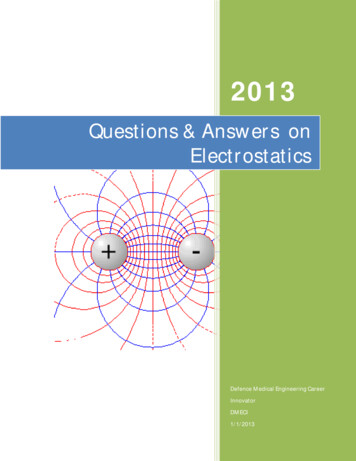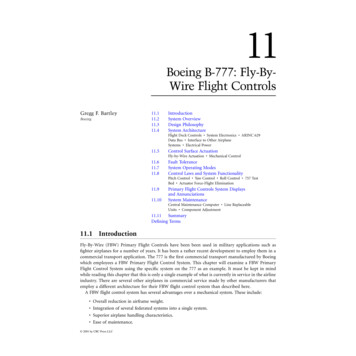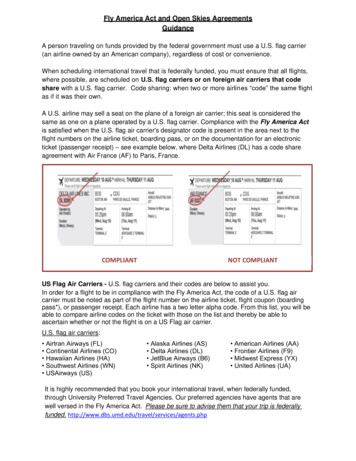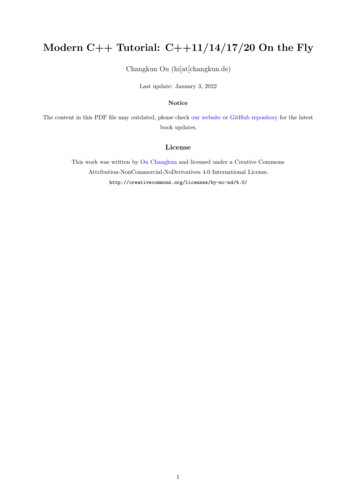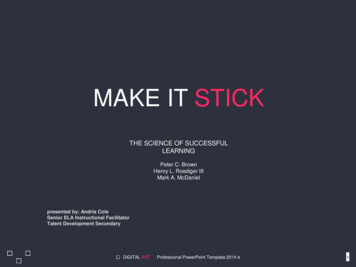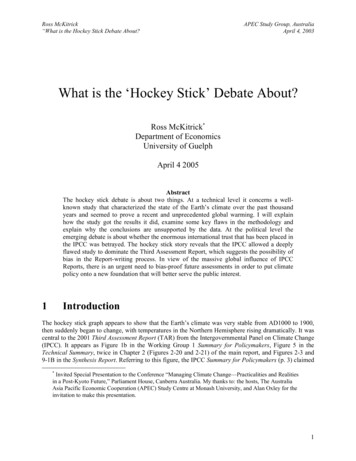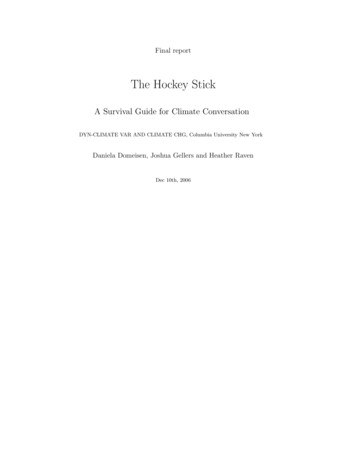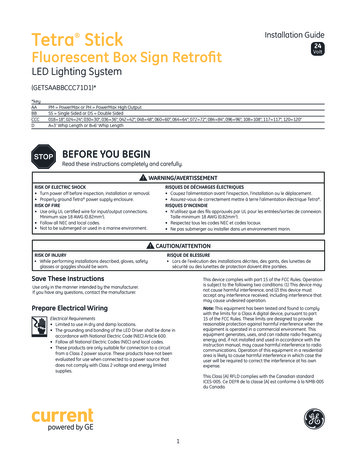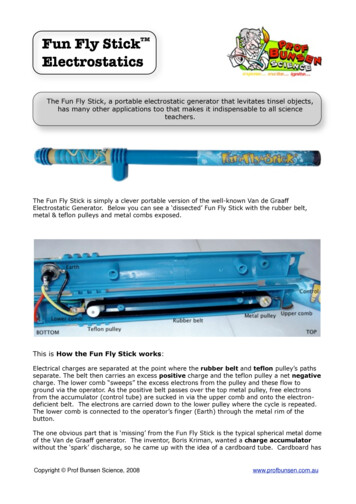
Transcription
Fun Fly Stick ElectrostaticsThe Fun Fly Stick, a portable electrostatic generator that levitates tinsel objects,has many other applications too that makes it indispensable to all scienceteachers.The Fun Fly Stick is simply a clever portable version of the well-known Van de GraaffElectrostatic Generator. Below you can see a ‘dissected’ Fun Fly Stick with the rubber belt,metal & teflon pulleys and metal combs exposed.This is How the Fun Fly Stick works:Electrical charges are separated at the point where the rubber belt and teflon pulley’s pathsseparate. The belt then carries an excess positive charge and the teflon pulley a net negativecharge. The lower comb “sweeps” the excess electrons from the pulley and these flow toground via the operator. As the positive belt passes over the top metal pulley, free electronsfrom the accumulator (control tube) are sucked in via the upper comb and onto the electrondeficient belt. The electrons are carried down to the lower pulley where the cycle is repeated.The lower comb is connected to the operator’s finger (Earth) through the metal rim of thebutton.The one obvious part that is ‘missing’ from the Fun Fly Stick is the typical spherical metal domeof the Van de Graaff generator. The inventor, Boris Kriman, wanted a charge accumulatorwithout the ‘spark’ discharge, so he came up with the idea of a cardboard tube. Cardboard hasCopyright Prof Bunsen Science, 2008www.profbunsen.com.au
a high electrical resistivity but becomes a conductor when subjected to high voltage electricity.Furthermore it discharges much slower than metal so the ‘shocking’ discharge sensation iseliminated. The result: A safe toy kids can use with no discomfort to the operator. Clever!Let’s quickly refresh our electrostatics basics: All matter is made up of atoms. Atoms consist of electrons orbiting the positive nucleus.Some atoms hold on very tightly to their electrons and others easily let go of them. When two dissimilar insulators (non-conductors) are in contact and then simply separated,one will lose electrons to the other. (Friction causes static too but is not required). Theinsulator that gains electrons has a surplus of electrons andbecomes electrically negatively charged. The other has lostTribo-electric serieselectrons and is labeled “positive” as it has an electrondeficiency.Positive The “tribo-electric series” indicates which materials easilygain (become negative) or easily lose electrons (becomepositive) when separated after being in contact. Rubbing aPVC pipe with a woolen cloth would therefore leave the pipewith a net negative charge and the cloth with a net positivecharge. The fact that every movement we make generates charges arenot well known as we seldom experience the discharges. We allknow that getting into a car seat on a dry day causes someuncomfortable discharges but we are unaware that wegenerate around 12000 to 39000 V on our bodies whencrossing a woolen carpet or 4000 to 13000 V when crossing avinyl floor! According to the Tribo-electric series, the Fun Fly Stick shouldgenerate a positive charge: Rubber vs Teflon. Confirm this inActivity 1 pperpolyesterpolystyrenePVCTeflonNegative Electrical charges can also be induced on a neighbouring insulator or conductor. If objectsdo not make contact then the charge will be of an opposite nature. If they do makecontact - as with the Fun Fly Stick and tinsel - then they both carry the same charge!Please NoteElectrostatic charges and water never go together, therefore: A humid, wet day would not be the best to try these activities; A hair dryer might be handy to dry the environment and objects before youstart; Evaporative cooling systems are deadly to electrostatics experiments asthese produce water vapour. When students gather, they breath water vapour, so keep the area wellventilated.Copyright Prof Bunsen Science, 2008www.profbunsen.com.au
Great Static Electricity Activities for your Classroomusing the Fun Fly StickTM.All of these can be easily converted to student centered activities.1. Determine the type of Charge on the Fun Fly Stick Find a piece of PVC pipe or PVC conduit and a woolen cloth. From the Tribo-electric Seriesabove we conclude that the PVC pipe will carry a net negative charge when rubbed with thecloth. Pull a piece of transparent sticky tape from its dispenser and affix to a table so that most ofthe tape hangs freely in the air. The tape carries an unknown charge. Rub the pipe with the cloth and bring the pipe close to the suspended tape. The movementof the tape will help you determine the charge on the tape. Deductive science! Oh yes,you still recall that like charges repel and opposite charges attract? Now, start the Fun Fly Stick and approach the tape. Once again the movement will giveaway the type of charge on the Fun Fly Stick. Cool!This can also be done without the PVC and cloth using a classroom electroscope.(Original idea by R Perkins, Educational Innovations)2. Determine the charge on the Fun Fly Stick with an ElectronicElectroscope.We have constructed an Electronic Electroscope using a field effect transistor (FET) and an LED.The LED glows brightly when the device is subjected to a positive electric field. This can beused to easily demonstrate the nature of the charge on the Fun Fly Stick and the PVC andcloth. The product is available as “Electroscope & Human Powered Lamp” atwww.profbunsen.com.auCopyright Prof Bunsen Science, 2008www.profbunsen.com.au
3. Bend a thin stream of water Cover the control tube of the Fun Fly Stick with a plastic zip lock bag. DO NOT get thecontrol tube wet! Have a thin stream of water flow from a faucet. The thinner the better. Approach the stream with the activated protected control tube. The bending of the streamshould show the attraction of the water to the charges on the Stick.Why? Water molecules are polar and arrange themselves in an electric field so they actjointly as tiny ‘magnets’. The negative poles of these polar molecules are attracted by thepositive charge of the Stick.4.Move an empty Soft Drink Can Find an empty soft drink can and place it on its side on a level surface. Start the Fun Fly Stick (positive charge) and hold the control tube parallel to the can. The can should roll toward the Stick. See how fast you can get it rolling without touchingthe Stick. Now - charge an inflated balloon (negative charge) by rubbing on dry hair. Bring the balloonclose to the can. Note that both positive and negative charges attract the can.Why? The Stick and balloon both induce opposite charges on the closest side of the soft drinkcan and opposite charges attract.Copyright Prof Bunsen Science, 2008www.profbunsen.com.au
5. Power a lamp with the Fun Fly Stick . . . really? Locate a high voltage neon lamp from an electronics supplier. We have used a 100V NE2neon lamp. Darken the room, hold one lead of the lamp with your fingers and bring the activated FunFly Stick close the the other lead. Note the orange / red glow gas discharge. You may also want to clamp one lead to a grounded metal clip and then approach the lampwith the Stick.6.Make an opposing Static Stick Find a piece of fur (rabbit skin) or woolen cloth and any piece of PVC tube. (A standard typeof plumbers’ down pipe works well.) Rub the cloth up and down on the tube. The PVC tube will build up a nett negative charge(see series above). Have someone fly a tinsel toy with the Fun Fly Stick (positive charge) and try to interceptthe toy. The tinsel should speed to your wand as it carries a positive charge. On touching itwill gain a net negative charge and speed off to the Fun Fly Stick. Rub the tube again toregain the charge. You may also want to drop a neutral tinsel toy onto the charged wand to see it come alive.Do not touch the wand else you will neutralize the wand.Copyright Prof Bunsen Science, 2008www.profbunsen.com.au
7. Float some Touchable Bubbles Buy a tube of touch-a-bubble mix and blow a few bubbles. Approach one bubble with the activated Fun Fly Stick. As the bubble touch the Stick, itacquires a like charge and speeds off. Try to charge another bubble and see the interactionamongst the two. “Like bubbles repel!” Additional idea: Fill a balloon with a little bit of helium gas so it barely floats. Now charge itand move it about the room with the Stick.8. Glue a sheet of paper to a wall Hold a sheet of paper against a white board or wall. Activate the Fun Fly Stick and stroke the paper with the control tube. Let go of the paperand ‘glue’ it onto the surface by moving the Stick up and down on the paper. Check how long it will stick. Compare different surfaces.Why? The sheet of paper touches the Stick and carries a slight positive charge and it getsstuck to the neutral wall through induction. As with paper, the wall is a poor conductor too andthe paper only drops after ionized air particles and electrons in the wall neutralize it.Copyright Prof Bunsen Science, 2008www.profbunsen.com.au
9. Feel the “electric wind” Position a large needle or thin metal axle on the end of the Fun Fly Stick control tube usingsome sticky stuff or a cork stopper. Lick the palm of your (clean!) hand and bring the needle close to the palm while activatingthe Fun Fly Stick. You should feel the coldness of moving ionized air particles, producing an‘electric wind’. You may want to push your luck a bit with the following: Place a burning candle close thetip of the needle. Make sure there are no drafts in the room. If you’re lucky you’ll see aslight movement of the flame. (This can be that intense on a Van de Graaff generator thatthe flame can be snuffed!)Why? Electrostatic charges are not distributed evenly on the surface of a needle. The chargeconcentration at the tip of the needle is so intense that it ionizes the air in its neighbourhood.Negative air ions will rush toward the needle tip and positive ions will move away due torepulsion. The movement of these ions create the ‘electric wind’.10.Fly rice bubbles or polystyrene spheres You will need an empty metal BeroccaTM effervescent tablet tube (or similar). Fill the tube with Rice Bubbles (breakfast cereal) so it protrudes above the tube. Place thetube on a polystyrene cup for insulation.Copyright Prof Bunsen Science, 2008www.profbunsen.com.au
Now, activate the Fun Fly Stick and “energize” the tube by bringing the Stick close to it.The top layers of Bubbles will fly off. When the ‘eruption’ stops, lower your (neutral) hand and see what happens. Small polystyrene spheres will do the same.11.Fly Flying SaucersThis demonstration will really challenge the output of the Fun Fly Stick. 12.Find a pack of the smallest aluminium pie pans you can get.Stack a number of them upside down on top of each other on a polystyrene cup.Activate the Fun Fly Stick and ‘energize’ the pans.It might take a few seconds but in a dry environment the pans should take off one after theother. You may lower your neutral hand to the pans to accelerate the process.Run an Electrostatic Motor Electrostatic motors are simply low friction electric motors based on the attraction andrepulsion of electric charges. The motor on the left is a high precision electrostatics motor from an American supplier. Itis easily powered by the Fun Fly Stick. (See our video online) The motor on the right is our DIY Film Canister Motor based on the Soft Drink Bottleelectrostatics motor design by William J Beaty (http://amasci.com/emotor/emot1.html).Copyright Prof Bunsen Science, 2008www.profbunsen.com.au
An empty film canister balances and rotates around a sharp axle. We have used anaquarium tube T-piece as a bearing for the metal axle. The two white tubes connected tothe T-piece has no function but to indicate the movement. The outer surface of the canisterhas a number of vertical copper foil adhesive strips stuck to it. You may use aluminium foilstrips glued on with contact adhesive. Copper or aluminium foil rolls with adhesive backingare found at craft supply stores. Two static film canisters flank the rotating canister. They are attached to the wooden basewith screws. Each has metal foil wrapped around it with a wire extending toward therotating canister (“brush wire”). Simply tape the wire to the metal foil. To operate: Position the brush wires as close as possible to the rotating canister. Touch onestatic canister with your finger and the activated Fun Fly Stick with the other. (You mayreplace your finger with a wire touching the metal rim of the button on the Fun Fly Stickand the static canister (Earthed wire)).Why?The static canister closes to the Fun Fly Stick acquires a positive charge imbalance due to thecontact from the Fun Fly Stick. The other static canister acquires a negative nett charge due toyour finger. Tiny sparks jump from the brush wires to the foil sectors closest to the brushes onthe rotor canister. The sector under the positive brush becomes positive, the one under thenegative brush becomes negative. The rotor's foil sectors are then repelled from the alikecharged static canister and attracted to the unlike charged static canister. This sidewayelectrostatic force causes the center canister to rotate, which brings new foil sectors under thebrushes and the process repeats.(Source: W J Beaty)13. Make an Electrostatic Drummer Locate a light-weight ball and glue a piece of yarn to it. Wrap the ball in thin aluminium foil. Suspend the ball from a bar or retort stand so that it is positioned mid-way between thebottom ends of two metal cans. The cans are best insulated from the work surface usingpolystyrene cups. Hold your finger to the one can and start the Fun Fly Stick. Approach the other can withthe Stick. The suspended ball should run to and throw between the two cans as it transfers charges,causing a drumming sound. Now - remove your hand. The periodical motion should stop. Why? Bring it back again.Why? This is a great demonstration of induction, attraction & repulsion. The neutral ball isattracted to the positive can due to induction. Once it touches the can it acquires the sameCopyright Prof Bunsen Science, 2008www.profbunsen.com.au
charge and is pushed off. It is attracted to the other can carrying the opposite charge, touchesthe can, is neutralized and acquires a net negative charge and speeds off in the other direction.And the process repeats itself . . .References Ford R A (1996) Homemade Lightning, New York: McGraw-Hill, 77 - 80 Email from Fun Fly Stick inventor, Boris Kriman, November 2008 Other sources as indicated in the textGo towww.profbunsen.com.auto order yourFun Fly Stick andsee some of the abovedemonstrations in video action.Copyright Prof Bunsen Science, 2008www.profbunsen.com.au
with the Stick. 6. Make an opposing Static Stick Find a piece of fur (rabbit skin) or woolen cloth and any piece of PVC tube. (A standard type of plumbers’ down pipe works well.) Rub the cloth up and down on the tube. The PVC tube

